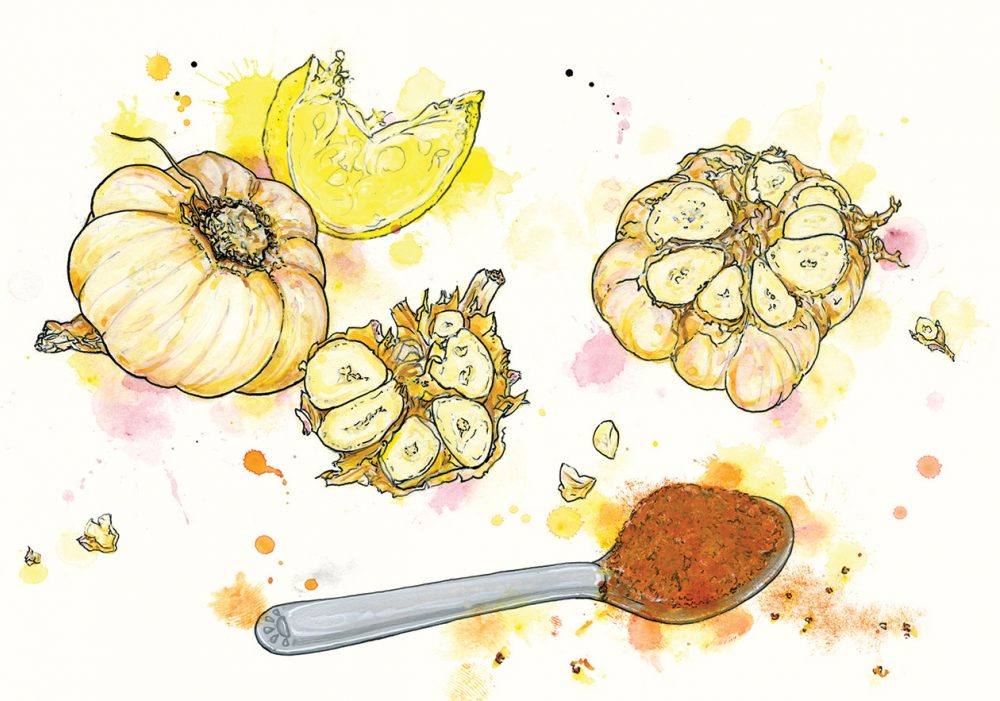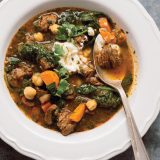I stopped making stews years ago. I blame our slavish adherence to the idea that flavor is built only by the tedious browning of meat at the start of a recipe.
It’s the cult of the Maillard reaction, the high heat-triggered response between proteins and simple sugars that produces the flavors and aromas we associate with seared and roasted meats.
There certainly is a time and place to play up Maillard—a grilled steak is a fine example. But the wet nature of stews means any browning must be done first and, even then, in small batches (else the meat steams instead of sears). It’s a messy, fussy and time-consuming process that I avoid. The good news is that when I went in search of like-minded cooks, I found a world full of them.
Almost every culture has a stew that eschews browning. They usually involve simmering tough cuts of meat (the shins and shoulders of the meat world) with potatoes or beans, then finishing with a massive handful of herbs and strong condiments like horseradish. Take Dutch hutspot or the Austrian Tafelspitz, for example.

Chopping or mincing garlic brings out its pungency.
Cooking the cloves or head whole, as when roasting, preserves its mellow flavor. We got similar results by simmering the head in the broth for the stew.
So how did we end up addicted to Maillard? Northern European cuisine has two things in abundance: meat and fuel. The English method of roasting meat over a wood or coal fire is a finely developed art. And thousands of recipes begin with “saute meat in a hot skillet or Dutch oven.” One might say that the definition of “cooking” in Northern Europe was, in large part, heat applied to meat.
But in cultures where fuel or meat was scarce (most of them), flavor had to be developed in other ways: Spices, strongly flavored condiments like fish sauce or soy sauce, fresh herbs, hot peppers, fresh ginger and animal fats all stood in for the flavors of browning. This means the heat-to-meat equation becomes less central to the overall dish. It also means that the finished stew is built from layers of flavor. But could we come up with a sear-free stew flavorful enough to satisfy Maillard-loving Americans?
We took our inspiration from a classic Yemeni dish, fahsa, which combines a judicious mix of aromatic vegetables with lamb or beef, warm spices and plenty of herbs. Carrots and chickpeas are a common pairing in stews such as this, and we liked the earthy sweetness they added. We wanted to use dry chickpeas because we usually prefer their texture and flavor, but canned were nearly as good and much faster.
Searing meat for stew is messy and fussy. The same savory flavors can be built—better and more easily—with abundant herbs and spices.
Next up was the meat. We love stewed lamb, the shoulder in particular because it packs plenty of collagen, which enhances the flavor and body of the broth. But we found the stew works equally well with beef.
To ensure that we got tender results as quickly as possible, we found it important to cut the meat into small pieces and to trim off all fat. Trimming was key because the meat was otherwise chewy and greasy when stewed.
Instead of browning the meat, we looked for other methods to build flavor. A dry seasoning mix—in this case paprika, cumin, cardamom, cinnamon, salt and pepper—was a good first step. We tried several approaches—rubbed on the meat, bloomed in fat, simmered in the cooking water—before realizing that the mix was best when doing double duty.
We rubbed half the mixture onto the lamb and briefly cooked the other half in the pot with onion, butter and tomato paste. Rubbing the meat ensured the lamb was richly seasoned. Cooking the seasonings with the fat (butter offered more complexity than olive oil) and tomato paste bloomed their flavors and lightly browned the tomato paste (which is high in sugar). This added the sort of deeply savory notes we usually get from browning the meat and provided an excellent base layer of flavor.
With our seasonings in place, we moved on to the main cooking event—adding the meat. First, we added water and brought it to a boil. This has the added benefit of deglazing the pan, pulling those flavorful bits of seasonings and tomato paste off the bottom. Then the meat went in. It was anticlimactic without searing, but that was the plan. It was the next step that provided a rich layer of extra flavor.
We knew we wanted garlic, but we didn’t want its harsh bite.
Slicing or mincing the cloves releases their aggressive sulfurous compounds. That’s when we got the idea to try a variation on oven-roasted garlic. When you roast garlic, the head is kept intact, with just the top sliced off. Drizzled with oil and wrapped in foil, the cloves get meltingly tender and have a pleasant sweet-savory flavor.
It would be too much trouble to separately roast the garlic, but we figured we could use the stew to do the work for us. So we sliced off the top of the head, then added it to the stew whole to cook alongside the meat. The result was transformative.
By the time the meat was cooked, the garlic cloves were tender. Clutching the head with tongs, we squeezed the softened cloves out of their husks directly into the stew. Stirred in, they added a whole new layer of mild but savory flavor as well as a pleasant body to the broth.
To finish the stew, we wanted a hit of bright, fresh flavors—yet another layer on top of the dry seasonings, the meat, the garlic and the vegetables. Some baby spinach, a handful of cilantro and a few tablespoons of lemon juice were just right.
By choosing ingredients that each played a distinct role in stew—and by adding them to the pot in order of the heft they contribute to the finished flavor—we were able to create a layered stew with less time, trouble and mess. And with no thanks to Monsieur Maillard!




